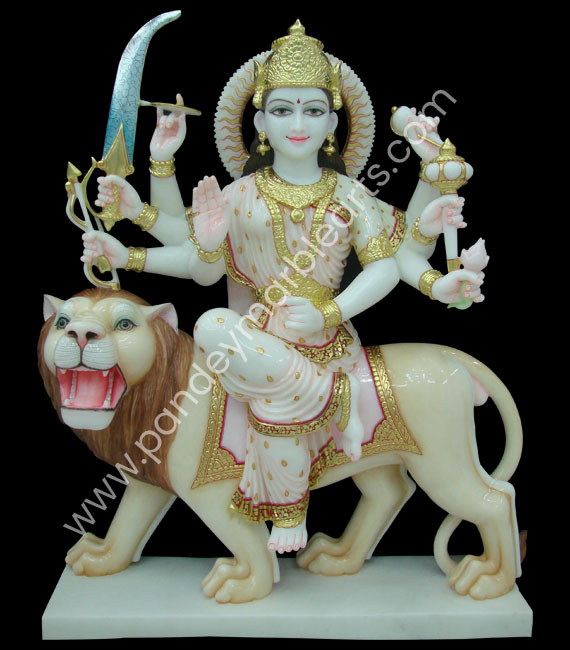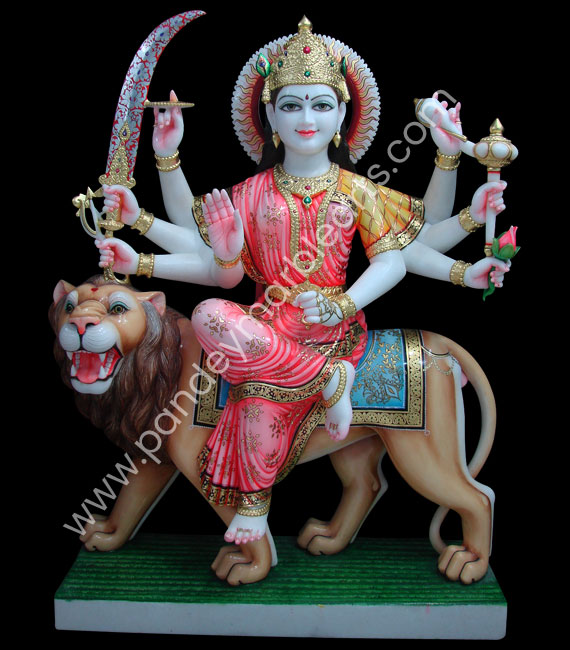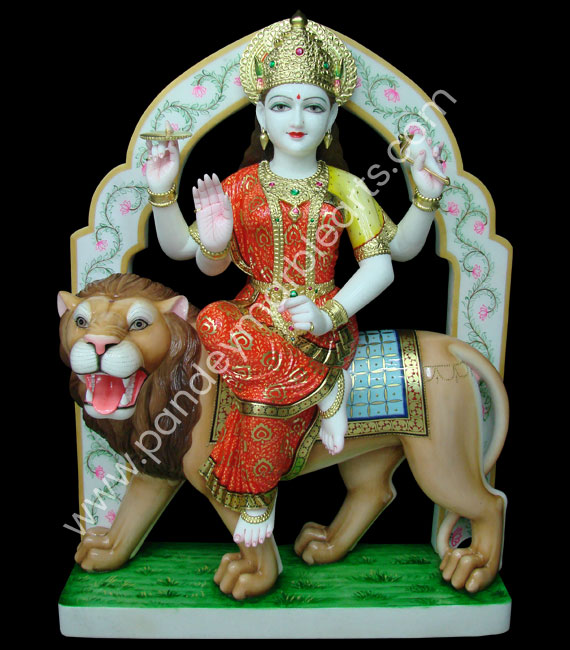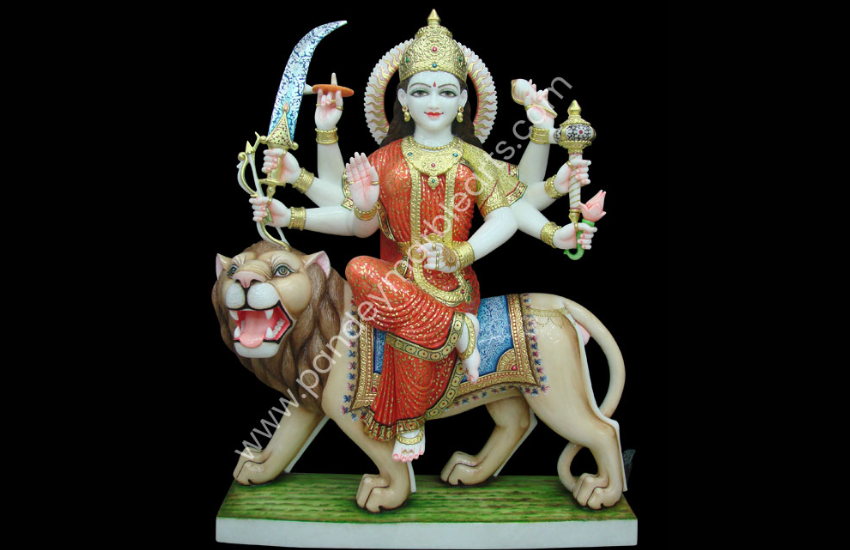Navratri is one of the most prominent Hindu festivals celebrated across India. Navratri is derived from the Sanskrit words ‘Nav’ (nine) and ‘Ratri’ (nights), meaning a nine-day festival of reverence, fasting, and celebration to honor Mata Durga. The festival is observed to perform pooja rituals of Durga Mata idols, and each day represents the victory or triumph of goodness, justice, and mercy over evil, and the divine feminine energy that protects creation.
The appearance of Maa Durga moorti, her multiple arms, weapons, and serene yet powerful expression, represents strength, courage, and wisdom. Welcoming a Maa Durga statue during Navratri is believed to bring inner strength, faith, and harmony.
In this blog, we will understand the symbolism behind Durga Mata idols during Navratri and how each roop (form) reflects timeless spiritual values.
Importance of Durga Puja in Navratri
Durga Mata idol worship is the central focus of Navratri. Every day of Navratri celebrates a different aspect of her energy: courage, wisdom, compassion, etc. A beautifully decorated marble swaroop of Goddess Durga becomes the focal point for prayers.
Devotees perform aarti, offer flowers, fruits, and sweets, and chant mantras to seek blessings. These practices are believed to remove negativity, inspire courage, and bring peace to homes. Decorating and worshipping the Durga Maa moorti also brings families and communities together. People gather to participate in rituals, celebrate with cultural programs, and share joy, making Navratri a festival of devotion and unity.

Observing these rituals faithfully encourages reflection, spiritual growth, and hope. For the millions who worship Durga Mata during Navratri, the festival is a time of great veneration of a goddess of divine powers who encourages resilience and a celebration of life’s blessings.
What Does a Durga Mata Idol Symbolize in Hinduism?
A Durga Mata idol symbolizes bravery, power, and the triumph of good over evil. The goddess is commonly portrayed with multiple arms, each holding a different weapon, signifying her strength and ability to protect devotees from all forms of negativity and danger. Her peaceful and serene face represents wisdom, compassion, and balance between power and peace.
The lion that often accompanies the idol symbolizes bravery and fearlessness. A Durga Maa idol always reminds people to face their fears and challenges with confidence and bravery.
During festivals like Navratri, the idol becomes a center of devotion, bringing communities together to celebrate faith and hope. Beyond rituals, the Durga Mata idol inspires individuals to conquer their inner challenges to grow, find resilience, and recognize that they can overcome negative forces that intrude upon their lives.
Why are Marble Moortis of Durga Mata Considered Auspicious?
According to the Hindu Shastra, marble is considered the purest and most auspicious material for Hindu gods’ idols, especially the white makrana marble. It is believed to carry prana (living energy) that promotes peace, purity, and positive vibrations in homes and temples. The smooth, radiant surface of marble reflects devotion and creates a sacred space ideal for prayer and meditation.
Devotees believe that having a marble idol brings prosperity, removes negative energy, and strengthens spiritual connection. The durability of marble ensures that these moortis last for generations, becoming a cherished part of family traditions and rituals.
During Navratri, marble moortis are beautifully adorned with flowers, clothes, and ornaments, making worship more engaging and inspiring devotion among family and community members. The elegance and purity of a marble idol elevate the spiritual atmosphere, encouraging focus, reverence, and inner peace.
What Do the Iconic Elements of a Durga Mata Murti Represent?
Every element of a Durga Mata murti carries deep meaning. The goddess is usually depicted sitting on a lion, which embodies bravery, courage, and fierceness. The lion signifies strength and the ability to overcome challenges, provoking devotees to accept obstacles with self-confidence and determination.

Durga Mata’s multiple arms represent her ability to protect her devotees from all directions and handle multiple responsibilities simultaneously. Each arm is holding weaponry or an object, depicting various powers like knowledge, strength, and protection. The trident represents the power to eliminate evil, the conch is the divine sound that awakens spiritual consciousness, and the lotus means purity, devotion, and spiritual growth.
Her calm and composed face is a sign of wisdom, balance, and compassion, showing that true strength comes with inner peace. The posture of the murti conveys readiness to act against negativity while maintaining serenity.
What are the Nine Forms of Goddess Durga and Their Idol Representations?
The nine forms of Goddess Durga symbolize different aspects of satvik energy. These forms are worshipped through idols, and each has specific attributes, posture, and weapons that convey spiritual lessons.
- Shailaputri: This is the first avatar of goddess Durga and is worshipped on the first day of Navratri. Mata Shailaputri rides a bull and holds a trident and a lotus flower. Mata Shailaputri signifies strength, devotion, and a relationship to nature.
- Brahmacharini: Worshipped on the second day, Mata Brahmacharini walks barefoot, holding a rosary and a water pot. She symbolizes penance, patience, and spiritual wisdom.
- Chandraghanta: The third form, worshipped on day three, depicts Mata Chandraghanta riding a tiger with a crescent moon on her forehead. She signifies bravery, fearlessness, and the ability to combat any negativity.
- Kushmanda: On the fourth day, devotees worship Mata Kushmanda, who rides a lion and holds weapons along with a rosary. The meaning of ‘Kushmanda’ is energy, creativity, and the source of all life.
- Skandamata: The fifth form, worshipped on day five, is Skandamata, who represents the notions of maternal love and nurturing with protection. As the mother of the God Kartikeya, she rides the lion and carries her child on her lap.
- Katyayani: Worshipped on the sixth day, Mata Katyayani is the goddess of courage, determination, and victory over evil who rides the lion and carries swords.
- Kalaratri: On the seventh day, devotees worship Mata Kalaratri, who has a fierce appearance and rides a donkey. She symbolizes the destruction of negativity and fear.
- Mahagauri: The eighth form, worshipped on day eight, depicts Mata Mahagauri riding a bull. She appears calm, pure, and radiant, symbolizing serenity, purity, and spiritual wisdom.
- Siddhidatri: Worshipped on the ninth day, Mata Siddhidatri sits on a lotus and holds symbols of knowledge. She grants wisdom, spiritual fulfillment, and blessings.

Conclusion
Navratri is a time to connect with the energy and teachings of Durga Mata. Each of her nine forms brings messages of courage, patience, purity, and protection, which empower devotees to conquer obstacles with faith. These celebrations bring families together, turning homes into spaces of devotion, joy, and reflection.
Undoubtedly, a well-crafted Durga Mata idol makes the celebrations even more meaningful. Many devotees prefer marble idols that are durable, detailed, and made with care, as these qualities deepen the sense of devotion. Pandey Moorti Bhandar creates idols that capture every symbolic element with care and devotion. The durability of marble moortis and the craftsmanship not only become the center.

